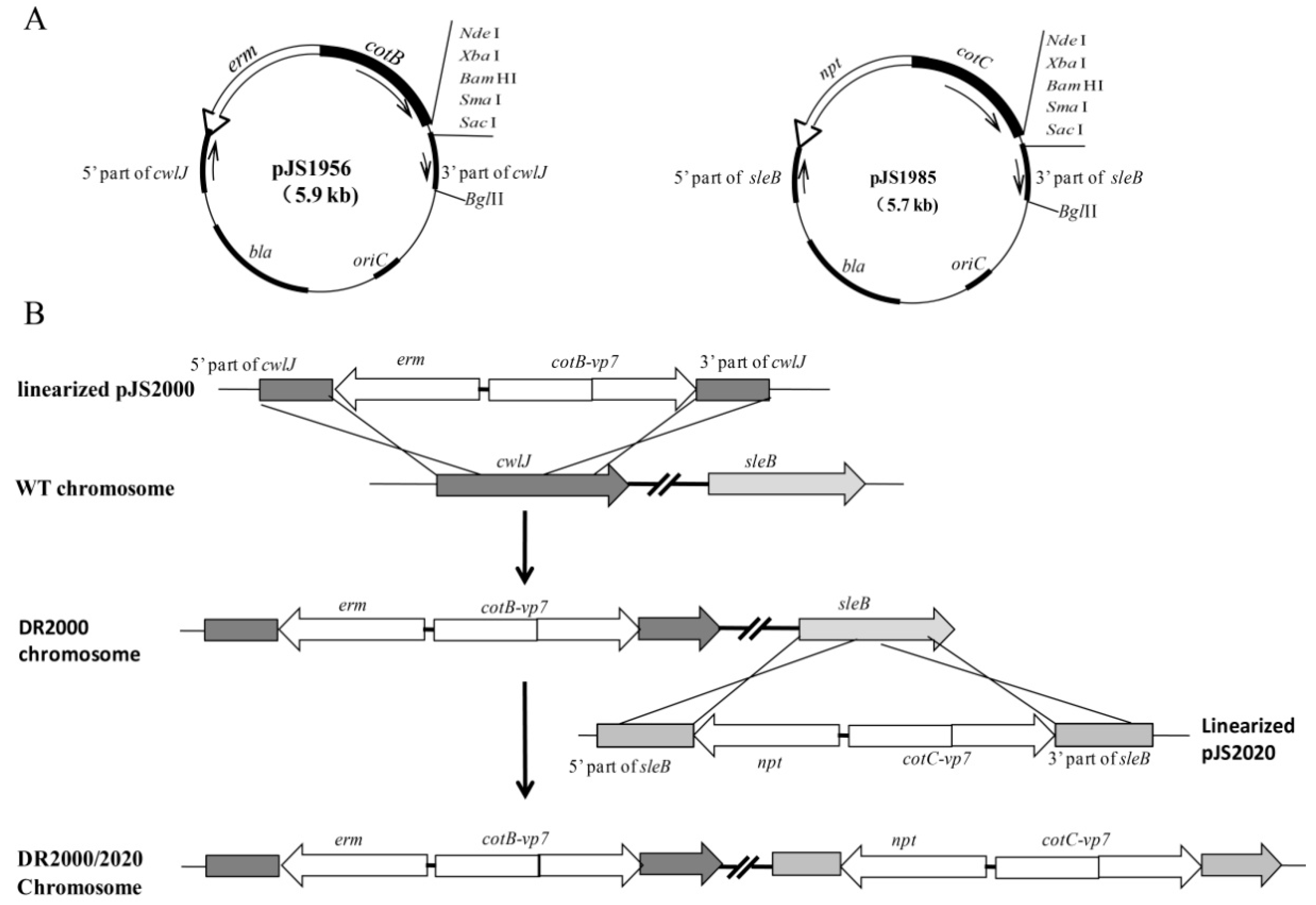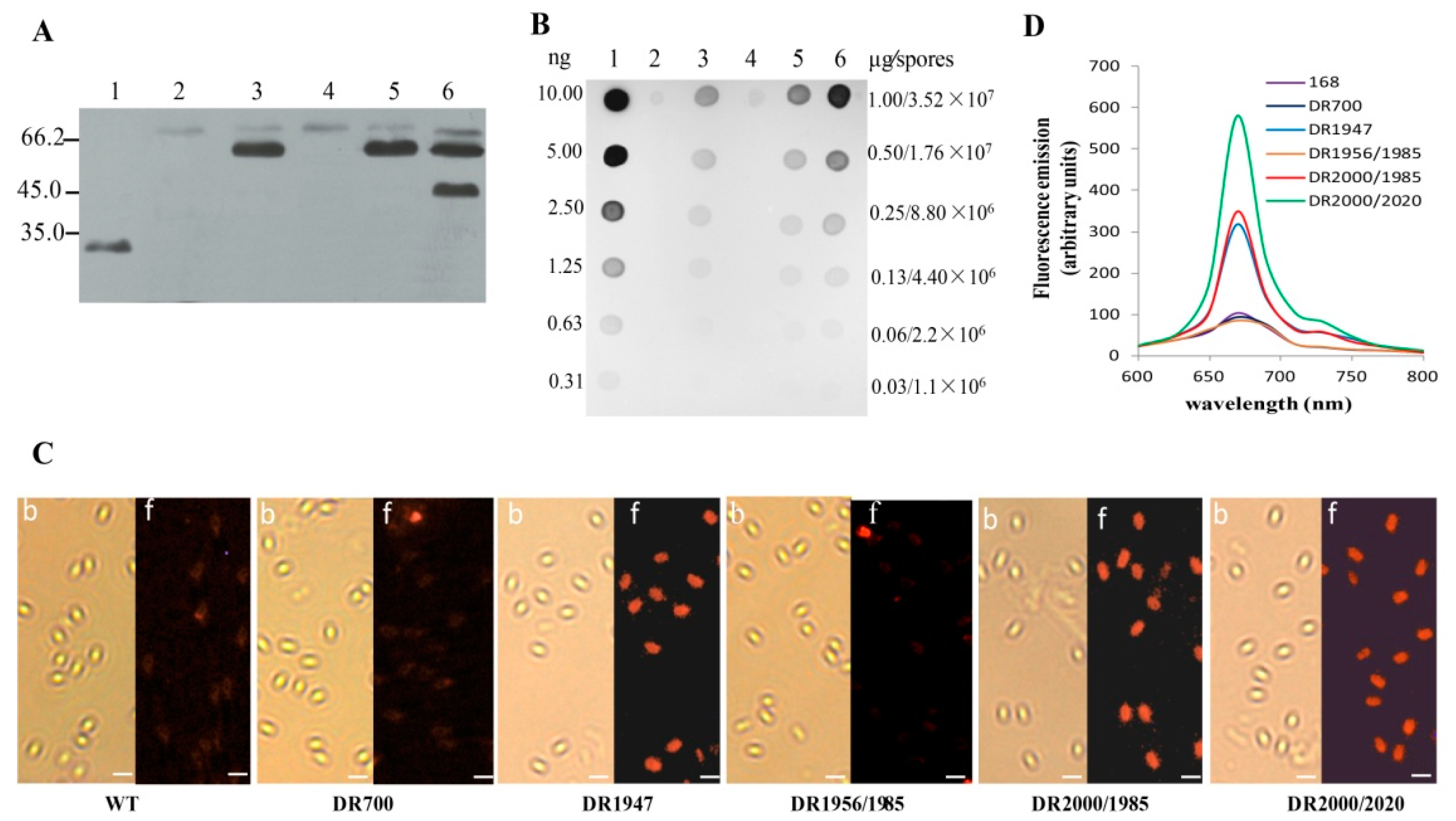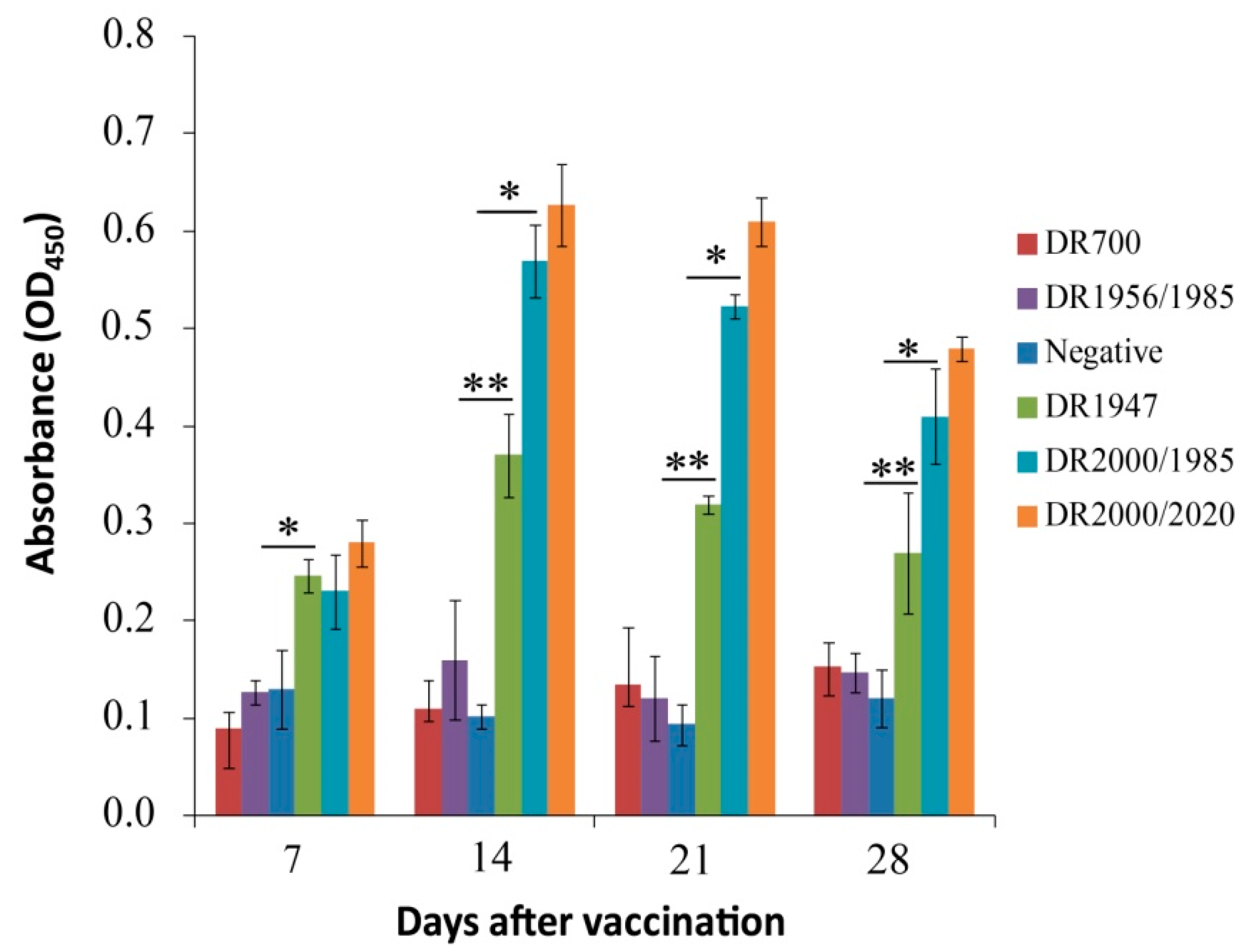Germination-Arrest Bacillus subtilis Spores as An Oral Delivery Vehicle of Grass Carp Reovirus (GCRV) Vp7 Antigen Augment Protective Immunity in Grass Carp (Ctenopharyngodon idella)
Abstract
1. Introduction
2. Materials and Methods
2.1. Strains and Growth Conditions
2.2. Construction of Plasmids and Recombinant B. Subtilis Strains
2.3. Spore Preparation and Germination Analysis
2.4. Preparation of the Recombinant Vp7 Protein and Rabbit Anti-Vp7 Antibody
2.5. Immunoblotting Analysis of Spore Coat Proteins
2.6. Immunofluorescence Analysis
2.7. Preparation of Experimental Fish and Spore-Coated Feed Pellets
2.8. Oral Administration, Sample Collection, and Challenge
2.9. Indirect Enzyme-Linked Immunosorbent Assay (ELISA) of Anti-Vp7 IgM Antibody
2.10. Total RNA Isolation, cDNA Synthesis and Quantitative Reverse Transcription PCR (qRT-PCR)
2.11. Statistical Analysis
3. Results
3.1. Recombinant B. Subtilis Strains
3.2. Spore Germination of Recombinant B. Subtilis Strains
3.3. Expression and Localization of Vp7 in the Recombinant Spores
3.4. Immune Responses of Grass Carp Following Oral Immunization
3.5. Protection of Grass Carp against GCRV after Oral Administration
4. Discussion
5. Conclusions
Supplementary Materials
Author Contributions
Funding
Acknowledgments
Conflicts of Interest
References
- Brudeseth, B.E.; Wiulsrod, R.; Fredriksen, B.N.; Lindmo, K.; Lokling, K.E.; Bordevik, M.; Steine, N.; Klevan, A.; Gravningen, K. Status and future perspectives of vaccines for industrialised fin-fish farming. Fish Shellfish Immunol. 2013, 35, 1759–1768. [Google Scholar] [CrossRef] [PubMed]
- Dhar, A.K.; Manna, S.K.; Thomas Allnutt, F.C. Viral vaccines for farmed finfish. Virusdisease 2014, 25, 1–17. [Google Scholar] [CrossRef] [PubMed]
- Hoelzer, K.; Bielke, L.; Blake, D.P.; Cox, E.; Cutting, S.M.; Devriendt, B.; Erlacher-Vindel, E.; Goossens, E.; Karaca, K.; Lemiere, S.; et al. Vaccines as alternatives to antibiotics for food producing animals. Part 2: New approaches and potential solutions. Vet. Res. 2018, 49, 70. [Google Scholar] [CrossRef] [PubMed]
- Mutoloki, S.; Munang’andu, H.M.; Evensen, O. Oral vaccination of fish—Antigen preparations, uptake, and immune induction. Front. Immunol. 2015, 6, 519. [Google Scholar] [CrossRef]
- Munang’andu, H.M.; Mutoloki, S.; Evensen, O. An overview of challenges limiting the design of protective mucosal vaccines for finfish. Front. Immunol. 2015, 6, 542. [Google Scholar] [CrossRef]
- Embregts, C.W.; Forlenza, M. Oral vaccination of fish: Lessons from humans and veterinary species. Dev. Comp. Immunol. 2016, 64, 118–137. [Google Scholar] [CrossRef]
- Unnikrishnan, M.; Rappuoli, R.; Serruto, D. Recombinant bacterial vaccines. Curr. Opin. Immunol. 2012, 24, 337–342. [Google Scholar] [CrossRef]
- Hong, H.A.; Duc, L.H.; Cutting, S.M. The use of bacterial spore formers as probiotics. FEMS Microbiol. Rev. 2015, 29, 813–835. [Google Scholar] [CrossRef]
- Ferreira, L.C.; Ferreira, R.C.; Schumann, W. Bacillus subtilis as a tool for vaccine development: From antigen factories to delivery vectors. An. Acad. Bras. Cienc. 2005, 77, 113–124. [Google Scholar] [CrossRef][Green Version]
- Oggioni, M.R.; Ciabattini, A.; Cuppone, A.M.; Pozzi, G. Bacillus spores for vaccine delivery. Vaccine 2003, 21 (Suppl. S2), S96–S101. [Google Scholar] [CrossRef]
- Lee, J.S.; Poo, H.; Han, D.P.; Hong, S.P.; Kim, K.; Cho, M.W.; Kim, E.; Sung, M.H.; Kim, C.J. Mucosal immunization with surface-dislayed severe acute respiratory syndrome coronavirus spike protein on Lactobacillus casei induces neutralizing antibodies in mice. J. Virol. 2006, 80, 4079–4087. [Google Scholar] [CrossRef] [PubMed]
- Barnes, A.G.; Cerovic, V.; Hobson, P.S.; Klavinskis, L.S. Bacillus subtilis spores: A novel microparticle adjuvant which can instruct a balanced Th1 and Th2 immune response to specific antigen. Eur. J. Immunol. 2007, 37, 1538–1547. [Google Scholar] [CrossRef] [PubMed]
- Knecht, L.D.; Pasini, P.; Daunert, S. Bacterial spores as platforms for bioanalytical and biomedical applications. Anal. Bioanal. Chem. 2011, 400, 977–989. [Google Scholar] [CrossRef] [PubMed]
- Tavares Batista, M.; Souza, R.D.; Paccez, J.D.; Luiz, W.B.; Ferreira, E.L.; Cavalcante, R.C.; Ferreira, R.C.; Ferreira, L.C. Gut adhesive Bacillus subtilis spores as a platform for mucosal delivery of antigens. Infect. Immun. 2014, 82, 1414–1423. [Google Scholar] [CrossRef]
- Casula, G.; Cutting, S.M. Bacillus probiotics: Spore germination in the gastrointestinal tract. Appl. Environ. Microbiol. 2002, 68, 2344–2352. [Google Scholar] [CrossRef]
- Bernardeau, M.; Lehtinen, M.J.; Forssten, S.D.; Nurminen, P. Importance of the gastrointestinal life cycle of Bacillus for probiotic functionality. J. Food Sci. Technol. 2017, 54, 2570–2584. [Google Scholar] [CrossRef]
- Setlow, P. Germination of spores of Bacillus species: What we know and do not know. J. Bacteriol. 2014, 196, 1297–1305. [Google Scholar] [CrossRef]
- Olguin-Araneda, V.; Banawas, S.; Sarker, M.R.; Paredes-Sabja, D. Recent advances in germination of Clostridium spores. Res. Microbiol. 2015, 166, 236–243. [Google Scholar] [CrossRef]
- Atluri, S.; Ragkousi, K.; Cortezzo, D.E.; Setlow, P. Cooperativity between different nutrient receptors in germination of spores of Bacillus subtilis and reduction of this cooperativity by alterations in the GerB receptor. J. Bacteriol. 2006, 188, 28–36. [Google Scholar] [CrossRef]
- Paidhungat, M.; Ragkousi, K.; Setlow, P. Genetic requirements for induction of germination of spores of Bacillus subtilis by Ca2+-dipicolinate. J. Bacteriol. 2001, 183, 4886–4893. [Google Scholar] [CrossRef]
- Setlow, P. Summer meeting 201—When the sleepers wake: The germination of spores of Bacillus species. J. Appl. Microbiol. 2013, 115, 1251–1268. [Google Scholar] [CrossRef] [PubMed]
- Shao, L.; Sun, X.; Fang, Q. Antibodies against outer-capsid proteins of grass carp reovirus expressed in E. coli are capable of neutralizing viral infectivity. Virol. J. 2011, 8, 347. [Google Scholar] [CrossRef] [PubMed]
- Rangel, A.A.; Rockemann, D.D.; Hetrick, F.M.; Samal, S.K. Identification of grass carp haemorrhage virus as a new genogroup of aquareovirus. J. Gen. Virol. 1999, 80, 2399–2402. [Google Scholar] [CrossRef] [PubMed]
- Sambrook, J.; Fritsch, E.F.; Maniatis, T. Molecular Cloning: A Laboratory Manual; Cold Spring Harbor Laboratory Press: Cold Spring Harbor, NY, USA, 1989. [Google Scholar]
- Ning, D.; Leng, X.; Li, Q.; Xu, W. Surface-displayed VP28 on Bacillus subtilis spores induce protection against white spot syndrome virus in crayfish by oral administration. J. Appl. Microbiol. 2011, 111, 1327–1336. [Google Scholar] [CrossRef] [PubMed]
- Vagner, V.; Dervyn, E.; Ehrlich, S.D. A vector for systematic gene inactivation in Bacillus subtilis. Microbiology 1998, 144, 3097–4004. [Google Scholar] [CrossRef] [PubMed]
- Wang, H.; Postier, B.L.; Burnap, R.L. Optimization of fusion PCR for in vitro construction of gene knockout fragments. Biotechniques 2002, 33, 26–32. [Google Scholar] [CrossRef]
- McKenzie, T.; Hoshino, T.; Tanaka, T.; Sueoka, N. A revision of the nucleotide sequence and functional map of pUB110. Plasmid 1987, 17, 83–85. [Google Scholar] [CrossRef]
- Cutting, S.M.; Horn, P.B.V. Genetic analysis. In Molecular Biological Methods for Bacillus; Harwood, C.R., Cutting, S.M., Eds.; John Wiley & Sons Ltd.: Chichester, UK, 1990; pp. 112–116. [Google Scholar]
- Nicholson, W.L.; Setlow, P. Sporulation, germination and outgrowth. In Molecular Biological Methods for Bacillus; Harwood, C.R., Cutting, S.M., Eds.; John Wiley & Sons Ltd.: Chichester, UK, 1990; pp. 203–207. [Google Scholar]
- Wang, N.; Wu, Y.; Pang, M.; Liu, J.; Lu, C.; Liu, Y. Protective efficacy of recombinant hemolysin co-regulated protein (Hcp) of Aeromonas hydrophila in common carp (Cyprinus carpio). Fish Shellfish Immunol. 2015, 46, 297–304. [Google Scholar] [CrossRef]
- Fang, Q.; Seng, E.; Ding, Q.; Zhang, L. Characterization of infectious particles of grass carp reovirus by treatment with proteases. Arch. Virol. 2008, 153, 675–682. [Google Scholar] [CrossRef]
- Zhu, B.; Liu, G.; Gong, Y.; Ling, F.; Wang, G. Protective immunity of grass carp immunized with DNA vaccine encoding the vp7 gene of grass carp reovirus using carbon nanotubes as a carrier molecule. Fish Shellfish Immunol. 2015, 42, 325–334. [Google Scholar] [CrossRef]
- Su, J.; Zhang, R.; Dong, J.; Yang, C. Evaluation of internal control genes for qRT-PCR normalization in tissues and cell culture for antiviral studies of grass carp (Ctenopharyngodon idella). Fish Shellfish Immunol. 2011, 30, 830–835. [Google Scholar] [CrossRef] [PubMed]
- Rao, X.; Huang, X.; Zhou, Z.; Lin, X. An improvement of the 2∧(-delta delta CT) method for quantitative real-time polymerase chain reaction data analysis. Biostat. Bioinforma. Biomath. 2013, 3, 71–85. [Google Scholar] [PubMed]
- Salinas, I.; Zhang, Y.A.; Sunyer, J.O. Mucosal immunoglobulins and B cells of teleost fish. Dev. Comp. Immunol. 2011, 35, 1346–1365. [Google Scholar] [CrossRef] [PubMed]
- Bengten, E.; Wilson, M. Antibody Repertoires in fish. Results Probl. Cell Differ. 2015, 57, 193–234. [Google Scholar] [PubMed]
- Magadan, S.; Sunyer, O.J.; Boudinot, P. Unique features of fish immune repertoires: Particularities of adaptive immunity within the largest group of vertebrates. Results Probl. Cell Differ. 2015, 57, 235–2364. [Google Scholar]
- Tracey, K.J.; Cerami, A. Tumor necrosis factor, other cytokines and disease. Annu. Rev. Cell Biol. 1993, 9, 317–343. [Google Scholar] [CrossRef]
- Baud, V.; Karin, M. Signal transduction by tumor necrosis factor and its relatives. Trends Cell Biol. 2001, 11, 372–377. [Google Scholar] [CrossRef]
- Mauriello, E.M.; Cangiano, G.; Maurano, F.; Saggese, V.; De Felice, M.; Rossi, M.; Ricca, Z. Germination-independent induction of cellular immune response by Bacillus subtilis spores displaying the C fragment of the tetanus toxin. Vaccine 2007, 25, 788–793. [Google Scholar] [CrossRef]
- Pelczar, P.L.; Igarashi, T.; Setlow, B.; Setlow, P. Role of GerD in germination of Bacillus subtilis spores. J. Bacteriol. 2007, 189, 1090–10988. [Google Scholar] [CrossRef]
- Moir, A.; Smith, D. The genetics of bacterial spore germination. Ann. Rev. Microbiol. 1990, 44, 531–553. [Google Scholar] [CrossRef]
- Li, X.; Du, H.; Liu, L.; You, X.; Wu, M.; Liao, Z. MHC class II α, β and MHC class II-associated invariant chains from Chinese sturgeon (Acipenser sinensis) and their response to immune stimulation. Fish Shellfish Immunol. 2017, 70, 1–12. [Google Scholar] [CrossRef] [PubMed]
- Somamoto, T.; Yoshiura, Y.; Nakanishi, T.; Ototake, M. Molecular cloning and characterization of two types of CD8alpha from ginbuna crucian carp, Carassius auratus langsdorfii. Dev. Comp. Immunol. 2005, 29, 693–702. [Google Scholar] [CrossRef] [PubMed]
- Yang, M.; Wang, Y.; Wang, X.; Chen, C.; Zhou, H. Characterization of grass carp (Ctenopharyngodon idellus) Foxp1a/1b/2: Evidence for their involvement in the activation of peripheral blood lymphocyte subpopulations. Fish Shellfish Immunol. 2010, 28, 289–295. [Google Scholar] [CrossRef] [PubMed]
- Zhang, Y.A.; Salinas, I.; Li, J.; Parra, D.; Bjork, S.; Xu, Z.; LaPatra, S.E.; Bartholomew, J.; Sunyer, J.O. IgT, a primitive immunoglobulin class specialized in mucosal immunity. Nat. Immunol. 2010, 11, 827–835. [Google Scholar] [CrossRef]
- Rombout, J.H.; Yang, G.; Kiron, V. Adaptive immune responses at mucosal surfaces of teleost fish. Fish Shellfish Immunol. 2014, 40, 634–643. [Google Scholar] [CrossRef]
- Hao, K.; Chen, X.; Qi, X.; Zhu, B.; Wang, G.; Ling, F. Display of GCRV vp7 protein on the surface of Escherichia coli and its immunoprotective effects in grass carp (Ctenopharyngodon idella). Fish Shellfish Immunol. 2018, 72, 199–209. [Google Scholar] [CrossRef]




| Plasmid | Characteristic Property or Genotype | Origen or Reference | |
|---|---|---|---|
| pJS700 | An integrative vector containing the integrative fragment amyE::erm-cotB | [25] | |
| pJS1947 | A derivative of pJS700, containing the integrative fragment amyE::erm-cotB-vp7 | This study | |
| pJS1956 | An integrative vector containing the integrative fragment cwlJ::erm-cotB | This study | |
| pJS1985 | An integrative vector containing the integrative fragment sleB::npt-cotC | This study | |
| pJS2000 | A derivative of pJS2016, containing the integrative fragment cwlJ::erm-cotB-vp7 | This study | |
| pJS2020 | A derivative of pJS1976, containing the integrative fragment sleB::npt-cotC-vp7 | This study | |
| pJS1621 | The vp7 gene in pET28a | This study | |
| B. subtilis | Relevant Genotype | Expressed Fusion Antigen 1 on Spore Surface | Origen or Reference |
| 168 (trp-) | Wild type (WT) | - | BGSC 2 |
| DR700 | amyE::erm-cotB | - | This study |
| DR1947 | amyE:erm-cotB-vp7 | CotB-Vp7, 60.7 kDa | This study |
| DR1956/1985 | cwlJ::erm-cotB; SleB::npt-cotC | - | This study |
| DR2000/1985 | cwlJ::erm-cotB-vp7; sleB::npt-cotC | CotB-Vp7, 60.7 kDa | This study |
| DR2000/2020 | cwlJ::erm-cotB-vp7; sleB::npt-cotC-vp7 | CotB-Vp7, 60.7 kDa; CotC-Vp7, 44.4 kDa | This study |
| Spore | No. of Spores 2 | CFU | Germination Efficiency 3 |
|---|---|---|---|
| WT168 | 4.64 × 108 | 4.58 × 108 | 99% |
| DR700 | 4.32 × 108 | 4.51 × 108 | 104% |
| DR1956DR1985 | 4.85 × 108 | 2.14 × 104 | 0.0044% |
| Group | Cumulative Mortality Rate (%) | RPS(%) | p Value 2 |
|---|---|---|---|
| Positive | 74.45 ± 3.14 | -- | -- |
| DR1947 | 53.33 ± 2.72 | 28.09 ± 1.79 | 0.036/-- |
| DR2000/1985 | 36.67 ± 1.57 | 50.66 ± 0.30 | 0.008/0.031 |
| DR2000/2020 | 32.22 ± 3.14 | 56.73 ± 2.82 | 0.007/0.024 |
Publisher’s Note: MDPI stays neutral with regard to jurisdictional claims in published maps and institutional affiliations. |
© 2020 by the authors. Licensee MDPI, Basel, Switzerland. This article is an open access article distributed under the terms and conditions of the Creative Commons Attribution (CC BY) license (http://creativecommons.org/licenses/by/4.0/).
Share and Cite
Sun, R.; Zhang, M.; Chen, H.; Wei, Y.; Ning, D. Germination-Arrest Bacillus subtilis Spores as An Oral Delivery Vehicle of Grass Carp Reovirus (GCRV) Vp7 Antigen Augment Protective Immunity in Grass Carp (Ctenopharyngodon idella). Genes 2020, 11, 1351. https://doi.org/10.3390/genes11111351
Sun R, Zhang M, Chen H, Wei Y, Ning D. Germination-Arrest Bacillus subtilis Spores as An Oral Delivery Vehicle of Grass Carp Reovirus (GCRV) Vp7 Antigen Augment Protective Immunity in Grass Carp (Ctenopharyngodon idella). Genes. 2020; 11(11):1351. https://doi.org/10.3390/genes11111351
Chicago/Turabian StyleSun, Rui, Miao Zhang, Hui Chen, Yao Wei, and Degang Ning. 2020. "Germination-Arrest Bacillus subtilis Spores as An Oral Delivery Vehicle of Grass Carp Reovirus (GCRV) Vp7 Antigen Augment Protective Immunity in Grass Carp (Ctenopharyngodon idella)" Genes 11, no. 11: 1351. https://doi.org/10.3390/genes11111351
APA StyleSun, R., Zhang, M., Chen, H., Wei, Y., & Ning, D. (2020). Germination-Arrest Bacillus subtilis Spores as An Oral Delivery Vehicle of Grass Carp Reovirus (GCRV) Vp7 Antigen Augment Protective Immunity in Grass Carp (Ctenopharyngodon idella). Genes, 11(11), 1351. https://doi.org/10.3390/genes11111351




